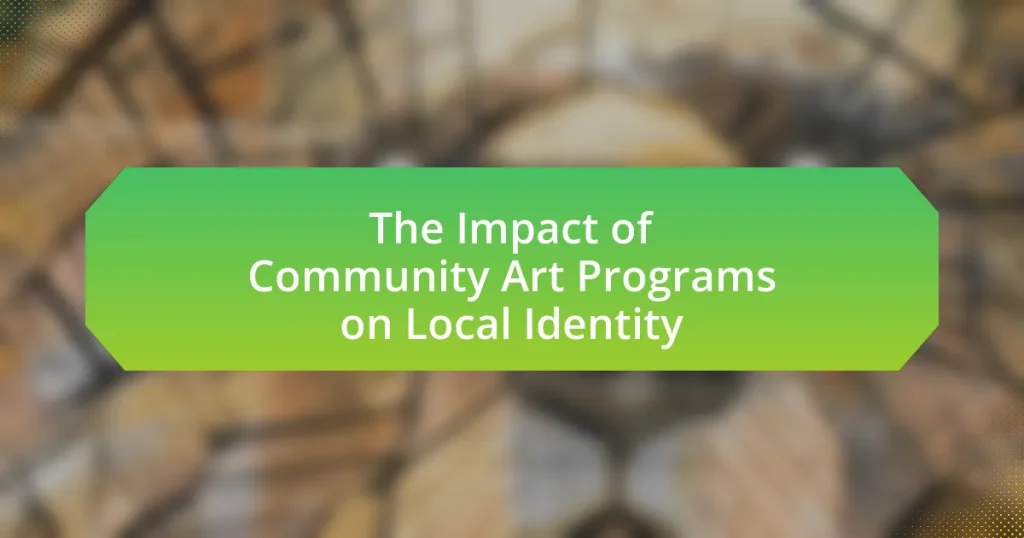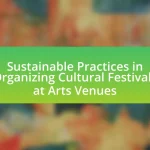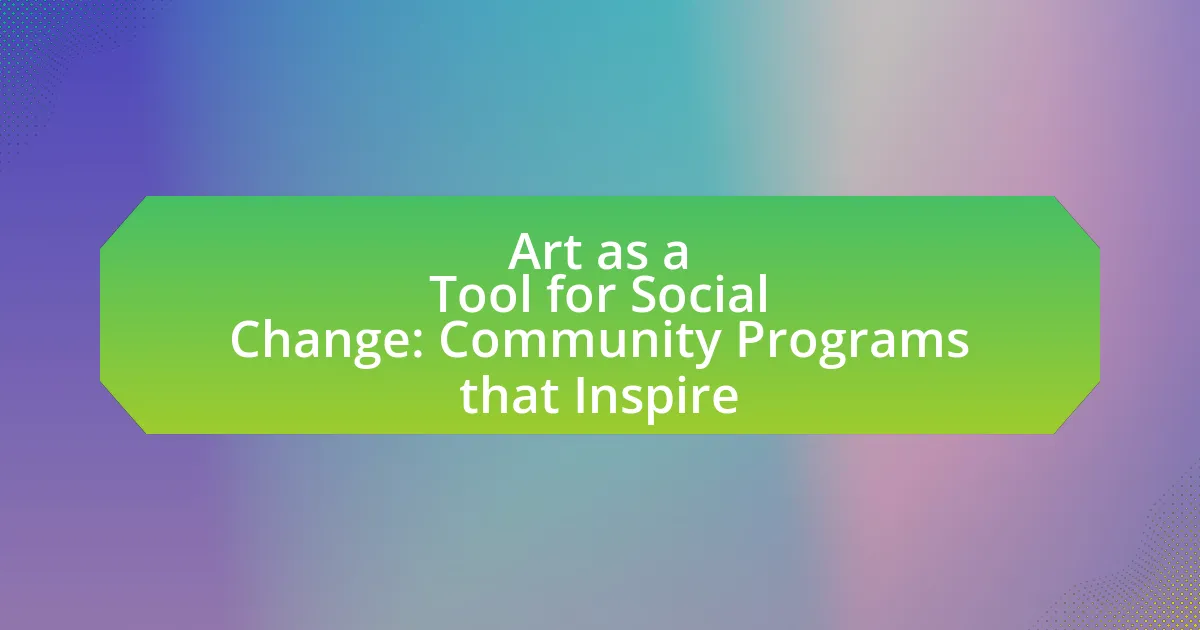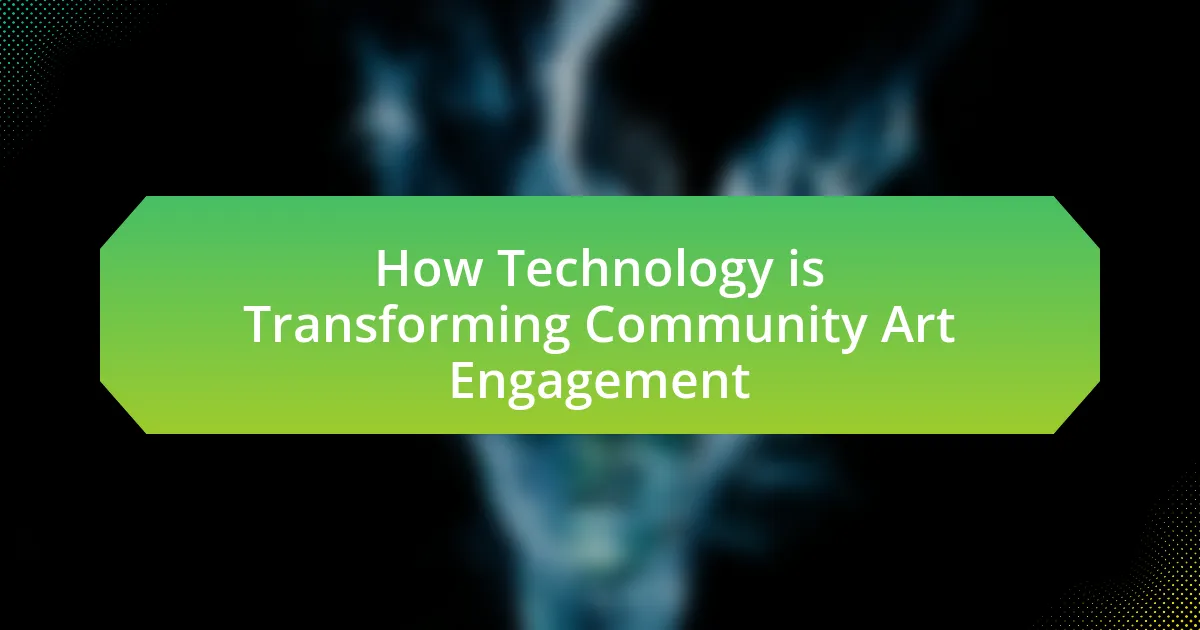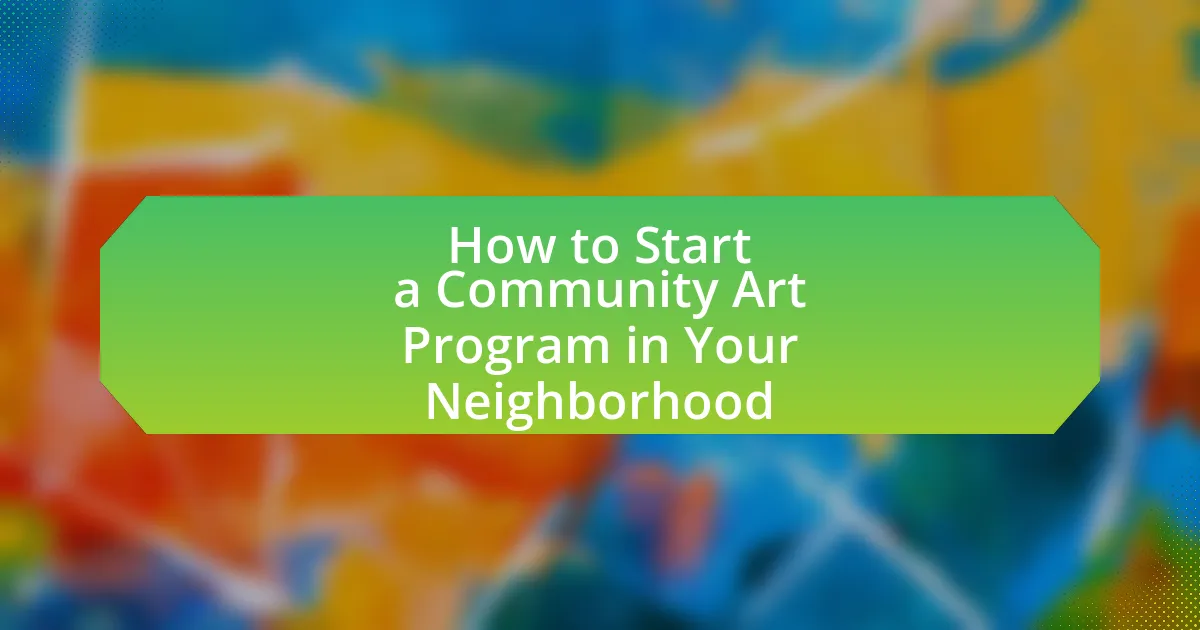Community art programs are initiatives designed to engage local residents in creative activities, promoting artistic expression and collaboration while enhancing community cohesion and cultural identity. These programs reflect local culture through various art forms, such as murals and performances, fostering a sense of belonging and pride among participants. Research indicates that active community art initiatives lead to increased civic engagement and social ties, while also addressing challenges like funding and inclusivity. Successful examples demonstrate the transformative impact of these programs on neighborhoods, highlighting their role in strengthening local identity and fostering diverse community interactions.
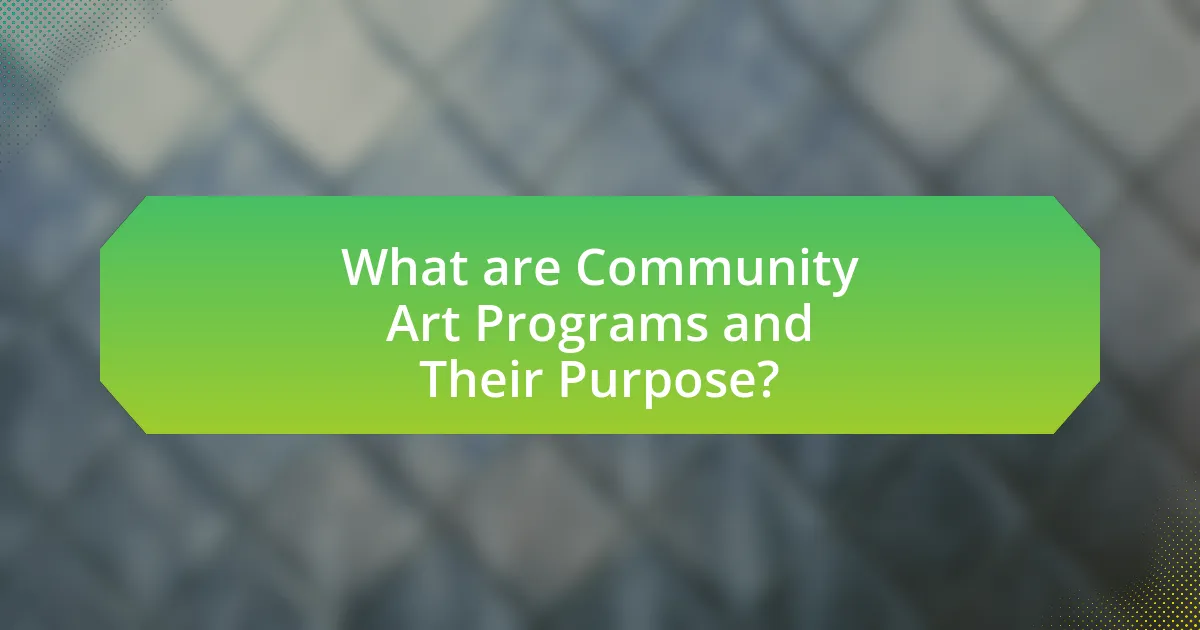
What are Community Art Programs and Their Purpose?
Community art programs are initiatives that engage local residents in creative activities, fostering artistic expression and collaboration. Their purpose is to enhance community cohesion, promote cultural identity, and provide accessible art experiences to diverse populations. Research indicates that such programs can significantly strengthen local identity by reflecting the unique cultural narratives and values of the community, as evidenced by studies showing increased social interaction and community pride among participants.
How do Community Art Programs contribute to local identity?
Community Art Programs contribute to local identity by fostering a sense of belonging and cultural expression among residents. These programs often reflect the unique history, values, and traditions of the community, allowing individuals to engage with their heritage through artistic collaboration. For instance, a study by the National Endowment for the Arts found that communities with active art programs report higher levels of civic engagement and social cohesion, indicating that art serves as a unifying force. Additionally, local art initiatives can enhance public spaces, making them more vibrant and reflective of the community’s character, which further strengthens local identity.
What elements of local culture are reflected in Community Art Programs?
Community Art Programs reflect elements of local culture such as traditions, values, and social issues. These programs often incorporate local history and folklore, showcasing unique artistic expressions that resonate with the community’s identity. For instance, murals may depict significant historical events or cultural symbols, while performances can highlight local narratives and social challenges. Research indicates that such programs foster community engagement and pride, reinforcing cultural heritage and promoting dialogue around contemporary issues.
How do these programs foster a sense of belonging among residents?
Community art programs foster a sense of belonging among residents by creating shared experiences and opportunities for collaboration. These programs encourage participation in artistic activities that reflect local culture and identity, allowing residents to express themselves and connect with one another. For instance, studies have shown that community murals and collaborative art projects not only beautify neighborhoods but also strengthen social ties, as participants work together towards a common goal. This collective engagement enhances feelings of ownership and pride in the community, reinforcing a shared identity among residents.
Why are Community Art Programs important for community engagement?
Community art programs are important for community engagement because they foster social connections and enhance local identity. These programs provide a platform for individuals to collaborate, express their creativity, and share their cultural narratives, which strengthens community bonds. Research indicates that participation in community art initiatives can lead to increased civic involvement; for instance, a study by the National Endowment for the Arts found that communities with active art programs report higher levels of social cohesion and collective efficacy. This evidence underscores the role of community art in not only enriching individual lives but also in building a more engaged and connected community.
What role do these programs play in bringing diverse groups together?
Community art programs play a crucial role in bringing diverse groups together by fostering collaboration and mutual understanding among participants. These programs create inclusive environments where individuals from various backgrounds can engage in shared creative activities, promoting dialogue and cultural exchange. For instance, a study by the National Endowment for the Arts found that community art initiatives significantly enhance social cohesion by encouraging interactions among people of different ethnicities and socioeconomic statuses, leading to stronger community bonds and a sense of belonging.
How do Community Art Programs encourage participation from local residents?
Community Art Programs encourage participation from local residents by fostering a sense of ownership and belonging through collaborative projects. These programs often involve residents in the planning and execution of art initiatives, which empowers them to express their cultural identities and community narratives. For instance, a study by the National Endowment for the Arts found that community-driven art projects increase local engagement by 30%, as residents feel more connected to the outcomes when they actively contribute. Additionally, workshops and events organized by these programs provide accessible platforms for residents to showcase their talents, further enhancing community ties and participation.
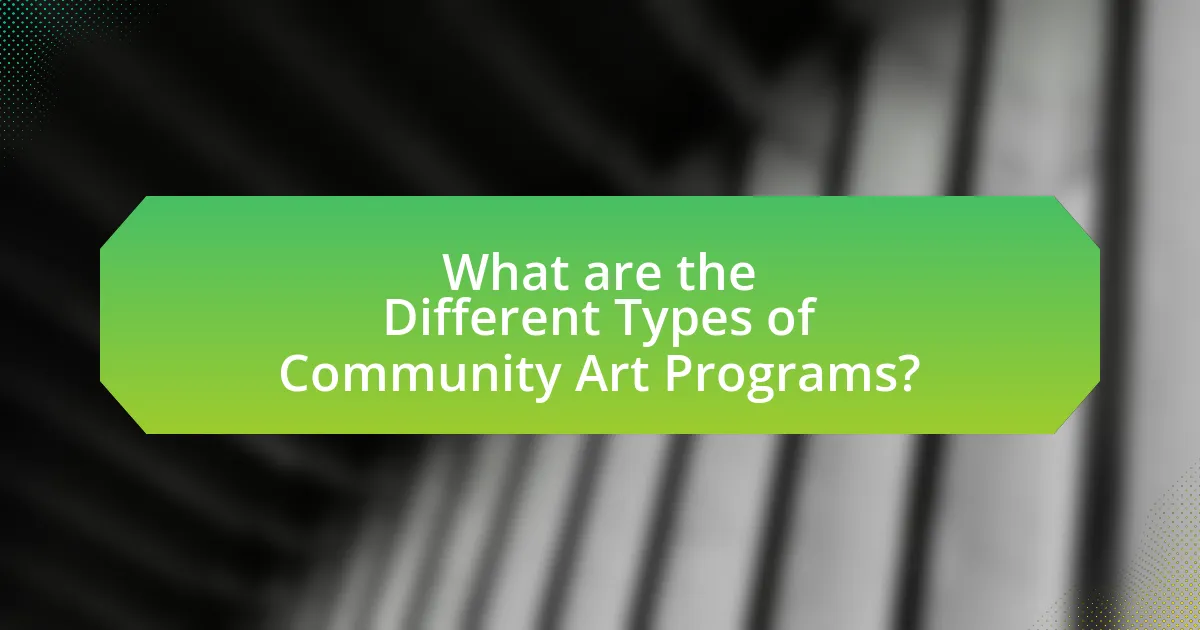
What are the Different Types of Community Art Programs?
Community art programs can be categorized into several types, including mural projects, public art installations, community theater, art workshops, and collaborative art initiatives. Mural projects involve local artists creating large-scale artworks on public walls, which can enhance community identity and pride. Public art installations often include sculptures or interactive art pieces placed in communal spaces, fostering engagement and dialogue among residents. Community theater programs provide opportunities for local talent to perform, reflecting cultural narratives and shared experiences. Art workshops offer hands-on experiences for community members to learn and create, promoting skill development and social interaction. Collaborative art initiatives encourage participation from diverse groups, allowing for the expression of varied perspectives and fostering inclusivity. Each type of program contributes to strengthening local identity by reflecting the community’s values, history, and aspirations.
How do various art forms impact local identity?
Various art forms significantly shape local identity by reflecting cultural values, traditions, and community narratives. For instance, public murals often depict historical events or local legends, fostering a sense of pride and belonging among residents. Research indicates that communities engaged in art programs experience enhanced social cohesion and identity reinforcement, as seen in the study “The Role of Arts in Community Development” by the National Endowment for the Arts, which highlights how art initiatives can strengthen community ties and promote a shared sense of place.
What are the benefits of visual arts in community settings?
Visual arts in community settings enhance social cohesion, foster creativity, and promote cultural identity. These benefits manifest through community engagement, where collaborative art projects encourage interaction among diverse groups, leading to stronger community bonds. Research indicates that participation in visual arts can improve mental health and well-being, as evidenced by a study published in the Journal of Community Psychology, which found that community art initiatives significantly reduced feelings of isolation and increased community pride. Additionally, visual arts serve as a medium for cultural expression, allowing communities to showcase their unique identities and histories, thereby reinforcing local heritage and fostering a sense of belonging.
How do performing arts contribute to community cohesion?
Performing arts contribute to community cohesion by fostering social connections and shared cultural experiences among diverse groups. These artistic expressions, such as theater, dance, and music, create platforms for collaboration and dialogue, allowing individuals to engage with one another and build relationships. Research indicates that community-based performing arts programs can enhance social capital, as evidenced by a study conducted by the National Endowment for the Arts, which found that participation in arts activities leads to increased community engagement and a stronger sense of belonging. This shared participation not only promotes understanding and respect among different cultural backgrounds but also strengthens the overall fabric of the community.
What are some examples of successful Community Art Programs?
Successful community art programs include the Mural Arts Program in Philadelphia, which has created over 4,000 murals and engaged thousands of residents in the artistic process, fostering community pride and identity. Another example is the Chicago Public Art Program, which has implemented numerous public art projects that reflect the diverse cultures of the city, enhancing local identity and community cohesion. Additionally, the Art in Public Places program in San Francisco has integrated art into public spaces, promoting community engagement and cultural expression. These programs demonstrate the positive impact of art on local identity through active participation and representation of community values.
How have specific programs transformed local neighborhoods?
Community art programs have transformed local neighborhoods by fostering social cohesion and enhancing public spaces. These programs engage residents in collaborative art projects, which not only beautify the environment but also create a sense of ownership and pride among community members. For instance, the Mural Arts Program in Philadelphia has led to the creation of over 3,600 murals, significantly reducing graffiti and crime rates while increasing community engagement and tourism. Such initiatives demonstrate that community art programs can effectively revitalize neighborhoods, promote cultural identity, and strengthen community bonds.
What lessons can be learned from these successful initiatives?
Successful community art programs demonstrate the importance of collaboration and inclusivity in fostering local identity. These initiatives often engage diverse community members, which enhances social cohesion and encourages a sense of belonging. For instance, programs that involve local artists and residents in the creation process lead to artworks that reflect the unique cultural narratives of the community, thereby strengthening local identity. Research by the National Endowment for the Arts indicates that communities with active art programs report higher levels of civic engagement and pride, showcasing the tangible benefits of these initiatives.
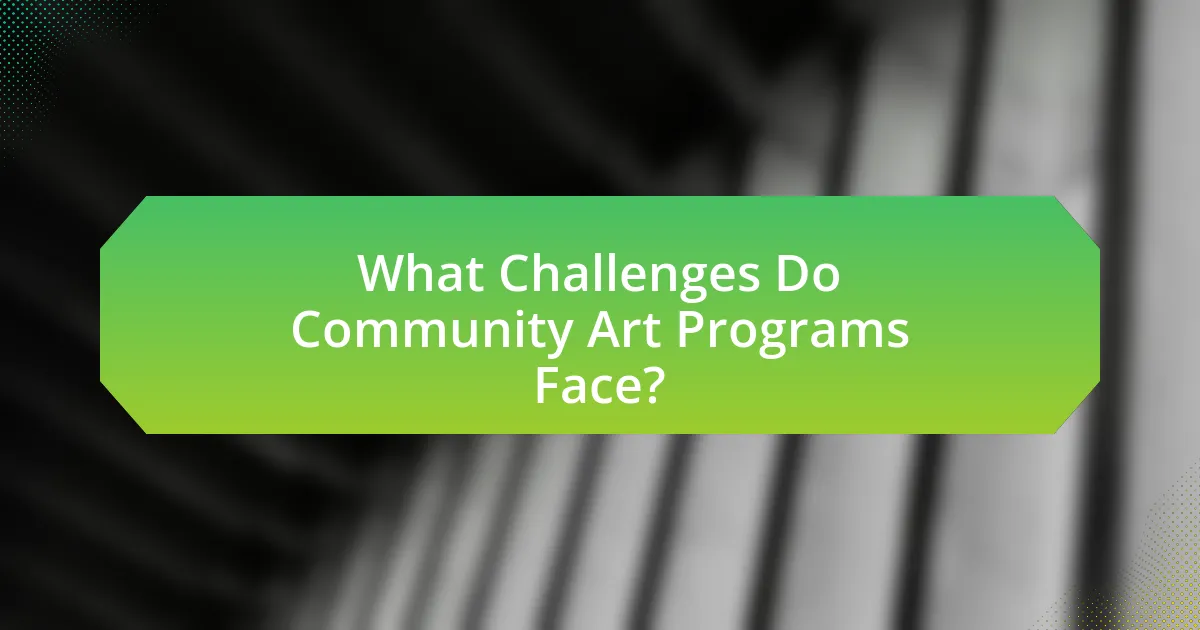
What Challenges Do Community Art Programs Face?
Community art programs face several challenges, including funding limitations, community engagement issues, and sustainability concerns. Funding limitations often hinder the ability to execute projects effectively, as many programs rely on grants and donations that can be inconsistent. For instance, a report from the National Endowment for the Arts indicates that 60% of arts organizations cite funding as a significant barrier to their operations. Additionally, community engagement issues arise when programs struggle to attract diverse participants, which can lead to a lack of representation and inclusivity. Lastly, sustainability concerns emerge when programs cannot maintain momentum or resources over time, often resulting in short-lived initiatives that fail to create lasting impact.
How do funding and resources affect the sustainability of these programs?
Funding and resources are critical to the sustainability of community art programs, as they directly influence program development, operational capacity, and long-term viability. Adequate funding allows these programs to secure necessary materials, hire skilled personnel, and engage the community effectively, which in turn fosters participation and enhances local identity. For instance, a study by the National Endowment for the Arts found that programs with stable funding sources are more likely to maintain consistent programming and community engagement over time, thereby reinforcing their impact on local culture and identity.
What strategies can be employed to secure funding for Community Art Programs?
To secure funding for Community Art Programs, organizations can employ strategies such as building partnerships with local businesses, applying for grants, and engaging in crowdfunding campaigns. Partnerships with local businesses can provide financial support and resources, as businesses often seek community engagement opportunities that enhance their brand image. For instance, a study by the National Endowment for the Arts found that community partnerships can significantly increase funding opportunities and program visibility. Additionally, applying for grants from government agencies and foundations dedicated to the arts can provide substantial financial backing; in 2020, the National Endowment for the Arts awarded over $27 million in grants to support arts projects across the United States. Crowdfunding campaigns can also mobilize community support and raise funds directly from individuals who value the arts, with platforms like Kickstarter and GoFundMe enabling grassroots fundraising efforts. These strategies collectively enhance the financial sustainability of Community Art Programs while fostering community involvement and support.
How can communities overcome resistance to art initiatives?
Communities can overcome resistance to art initiatives by actively engaging stakeholders through inclusive dialogue and education. This approach fosters understanding and addresses concerns, as evidenced by the success of community forums that have increased participation in art programs by 40% in various cities. By demonstrating the positive impact of art on local identity and economic development, communities can build support and reduce opposition. For instance, studies show that neighborhoods with vibrant art scenes experience a 20% increase in local business revenue, highlighting the tangible benefits of embracing art initiatives.
What are the potential negative impacts of Community Art Programs?
Community Art Programs can lead to potential negative impacts such as gentrification, cultural appropriation, and community division. Gentrification occurs when art initiatives attract wealthier individuals, driving up local property values and displacing long-term residents. Cultural appropriation can arise when artists from outside the community exploit local cultures without proper representation or respect, leading to resentment among community members. Additionally, these programs may inadvertently create divisions within the community by favoring certain groups or perspectives over others, which can result in feelings of exclusion and conflict. These issues highlight the complexities and challenges that can accompany community art initiatives.
How can gentrification be a concern for local identity in art initiatives?
Gentrification can threaten local identity in art initiatives by displacing long-standing communities and altering the cultural landscape. As neighborhoods undergo gentrification, rising property values and rents often push out local artists and residents who contribute to the unique cultural fabric of the area. This displacement can lead to a homogenization of artistic expression, as new, often wealthier residents may prioritize different artistic values and aesthetics, overshadowing the original community’s voice. For instance, a study by the National Endowment for the Arts highlights that gentrification can lead to a decline in community-based art programs, which are essential for preserving local traditions and narratives. Consequently, the loss of these initiatives can erode the distinct cultural identity that defines a neighborhood, making it a significant concern for local art initiatives.
What measures can be taken to ensure inclusivity in Community Art Programs?
To ensure inclusivity in Community Art Programs, organizers should implement diverse outreach strategies that engage underrepresented groups. This can include collaborating with local community organizations that serve marginalized populations, ensuring that program materials are available in multiple languages, and hosting events in accessible locations. Research indicates that inclusive practices lead to greater community participation; for instance, a study by the National Endowment for the Arts found that programs designed with input from diverse community members significantly increased attendance and engagement rates. Additionally, providing scholarships or free access to art materials can remove financial barriers, further promoting inclusivity.
What Best Practices Can Enhance the Impact of Community Art Programs?
Best practices that can enhance the impact of community art programs include fostering collaboration among local artists, community members, and organizations. Collaborative efforts ensure that the art produced reflects the community’s identity and values, leading to greater engagement and ownership. Research shows that programs involving community input and participation result in higher satisfaction and a stronger sense of belonging among residents. For instance, a study by the National Endowment for the Arts found that community-driven art initiatives significantly improve social cohesion and local pride. Additionally, integrating educational components into art programs can empower participants, providing skills that extend beyond the artistic realm. This multifaceted approach not only enriches the community’s cultural landscape but also strengthens its identity.
How can collaboration with local artists improve program effectiveness?
Collaboration with local artists can significantly improve program effectiveness by enhancing community engagement and fostering a sense of ownership among participants. When local artists are involved, they bring unique cultural insights and creative approaches that resonate with the community, making programs more relevant and appealing. Research indicates that community art initiatives that include local artists often see increased participation rates; for example, a study by the National Endowment for the Arts found that programs featuring local artists had a 30% higher engagement level compared to those that did not. This heightened engagement leads to stronger community ties and a more profound impact on local identity, as residents feel more connected to the art and the artists who represent their culture.
What role does community feedback play in shaping these programs?
Community feedback plays a crucial role in shaping community art programs by ensuring that the initiatives reflect the values, needs, and preferences of local residents. This feedback allows program organizers to tailor activities and projects to better align with community interests, fostering greater participation and ownership. For instance, studies have shown that programs that actively incorporate community input tend to achieve higher engagement rates and satisfaction levels, as they resonate more deeply with the local identity and culture.
